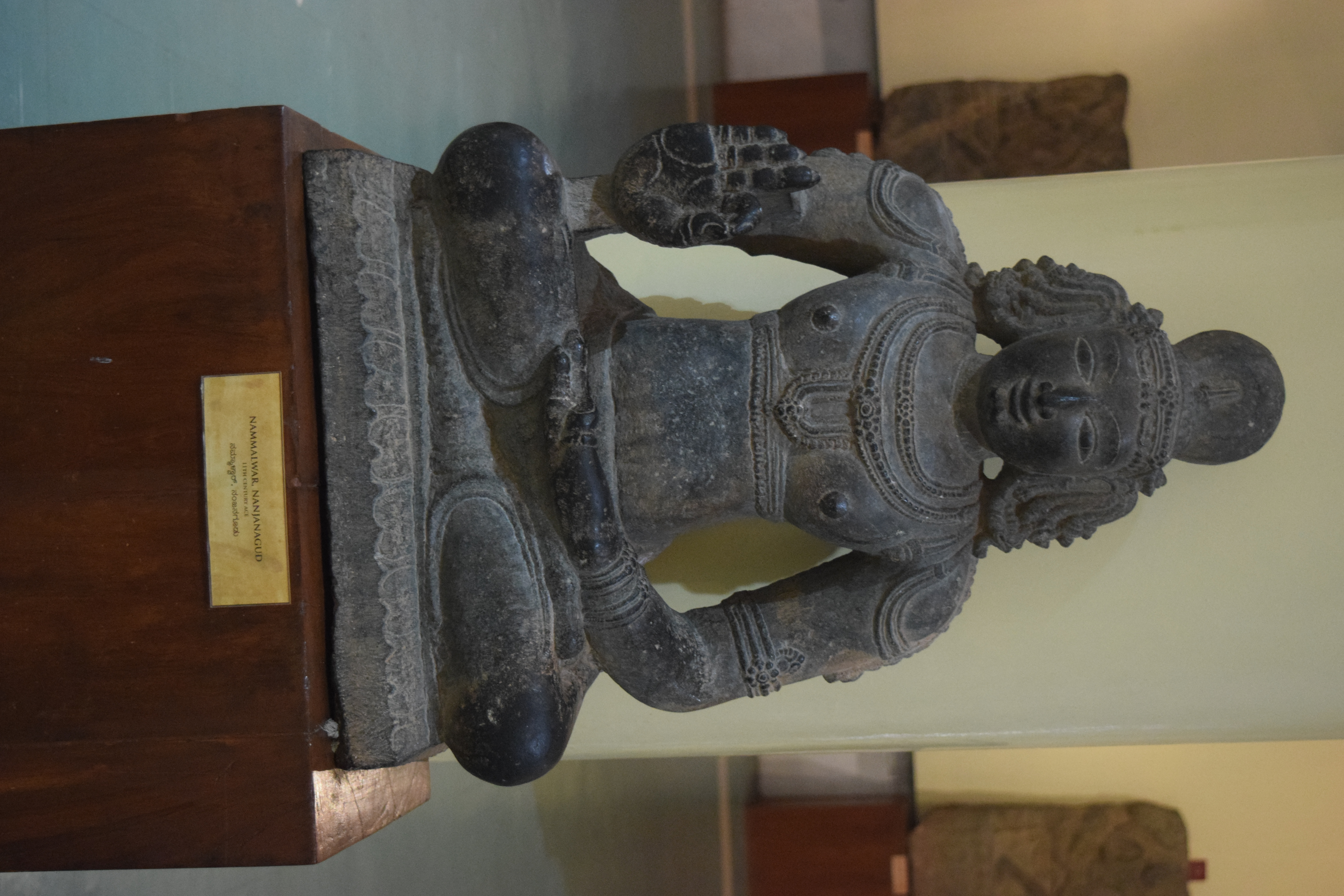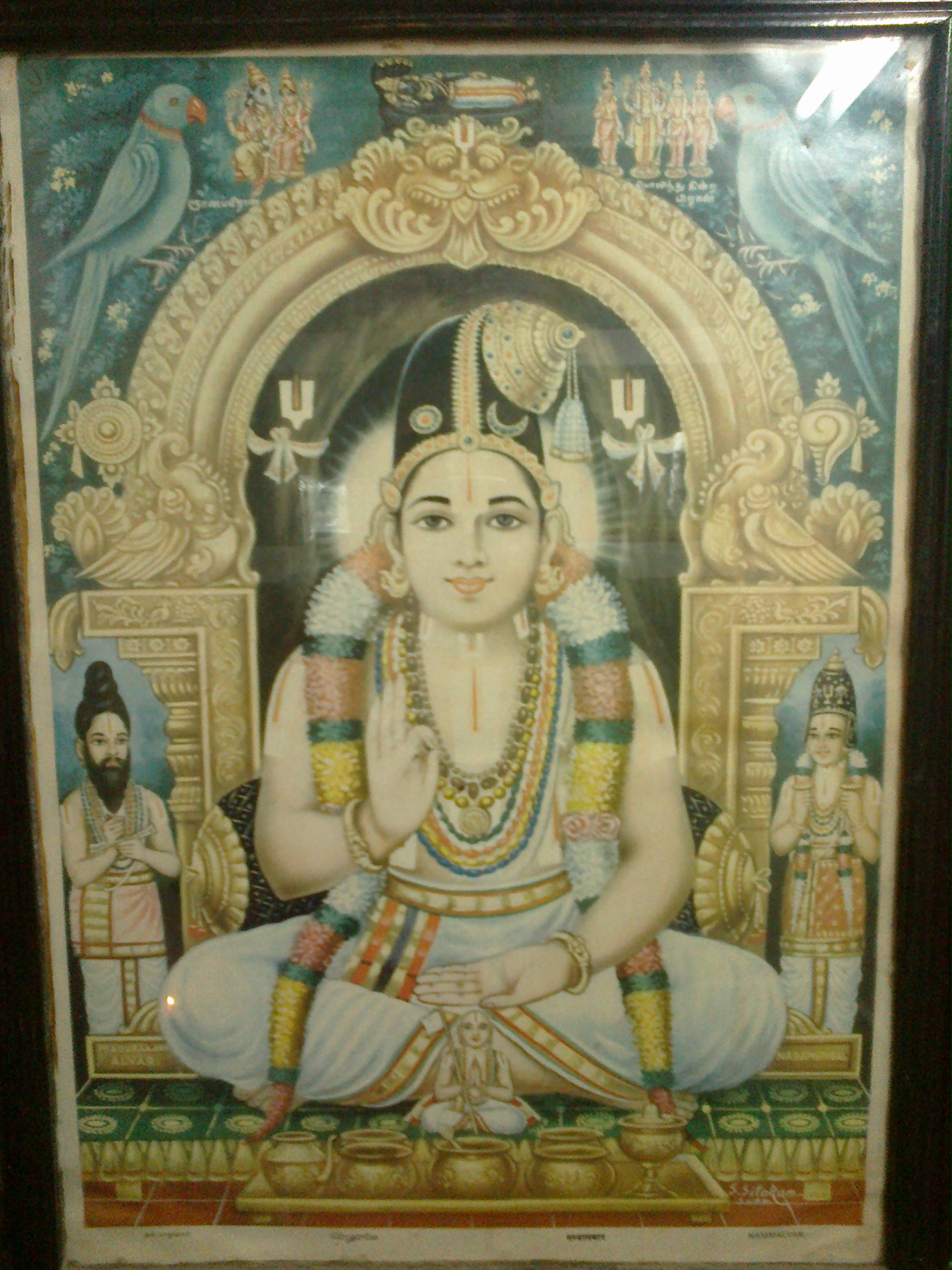|
Tiruviruttam
The Tiruviruttam () is a hundred-verse poem composed by Nammalvar, a poet-saint of the Sri Vaishnava tradition. It is one of the many works present in the compilation known as the Naalayira Divya Prabandham. According to tradition, it is said to contain the quintessence of the Rigveda. Structure The Tiruviruttam is framed as a love story that unfolds between an anonymous heroine (''talaivi'') and her beloved hero (''talaivan''), while friends, fortune tellers, bees, birds, and the poet’s own heart play important supporting roles, acting as messengers, lamenters, and audiences in the style of a story. According to some interpretations, this poem is regarded to take the form of a dramatic sequence, in which a few characters discuss the love of God, which is portrayed as the earthly love between a man and a woman. In this regard, the poet Nammalvar's yearning for God expresses itself through a woman's love-tossed heart pining for her omnipotent lover. Secular love for a man by a wo ... [...More Info...] [...Related Items...] OR: [Wikipedia] [Google] [Baidu] |
Nammalvar
Nammalvar (Tamil: நம்மாழ்வார், lit. 'Our Alvar') was one of the twelve Alvar saints of Tamil Nadu, India, who are known for their affiliation to the Vaishnava tradition of Hinduism. The verses of the Alvars are compiled as the Naalayira Divya Prabandham, where praises are sung of 108 temples that are classified as divine realms, called the Divya Desams. Nammalvar is considered to be the fifth in the line of the twelve Alvars. He was born in a Shudra family, but his pursuit of knowledge accorded him the respect of a Brahmin. He is highly regarded as a great mystic of the Vaishnava tradition. He is also considered to be the foremost among the twelve Alvars, and his contributions amount to 1352 among the 4000 stanzas in the ''Naalayira Divya Prabandam''. According to traditional scriptures, Nammalvar was born in 3059 BCE in Alwarthirunagiri; historically he flourished in 8th century CE. In Hindu legends, Nammalvar remained speechless from the moment of his b ... [...More Info...] [...Related Items...] OR: [Wikipedia] [Google] [Baidu] |
Naalayira Divya Prabandham
The Naalayira Divya Prabandham ( ta, நாலாயிரத் திவ்வியப் பிரபந்தம், lit=Four Thousand Divine Hymns, translit=Nālāyira Divya Prabandham) is a collection of 4,000 Tamil verses composed by the 12 Alvars. It was compiled in its present form by Nathamuni during the 9th–10th centuries. The work, an important liturgical compilation of the Tamil Alvars, marks the beginning of the canonisation of 12 ''Vaishnava'' poet saints, and these hymns are still sung extensively today. The works were lost before they were collected and organised in the form of an anthology by Nathamuni. Description The ''Divya Prabandham'' sings the praises of Narayana (Vishnu) and his many forms. The Alvars sang these songs at various sacred shrines known as the Divya Desams. The Tamil ''Vaishnavites'' are also known as ''Ubhaya Vedanti'' (those that follow both Vedas, that is, the Sanskrit Rigveda, Yajurveda, Samaveda, and Atharvaveda, as well as the ... [...More Info...] [...Related Items...] OR: [Wikipedia] [Google] [Baidu] |
Perumal Tirumoli
Perumal Tirumoli () is a compilation of hymns written by Kulasekhara Alvar, one of the Alvars, the poet-saints of the Sri Vaishnava tradition. This work, which is a part of the Naalayira Divya Prabandham, consists of 105 hymns, that are numbered 647 to 750 in the compendium. It is dedicated to the worship of Vishnu, who is often referred to as Perumal. Hymns The Perumal Tirumoli notably contain five decads on the holy town of Srirangam, and five each on Rama and Krishna, the latter considered to be of great poetic merit. The first ''pasuram'', or hymn, of this work is as follows: See also * Periyalvar Tirumoli * Nachiyar Tirumoli * Tiruviruttam The Tiruviruttam () is a hundred-verse poem composed by Nammalvar, a poet-saint of the Sri Vaishnava tradition. It is one of the many works present in the compilation known as the Naalayira Divya Prabandham. According to tradition, it is said to c ... References {{Reflist External links * '' My Sapphire-hued Lord, My Beloved ... [...More Info...] [...Related Items...] OR: [Wikipedia] [Google] [Baidu] |
Government Museum Bangalore DSC 5659
A government is the system or group of people governing an organized community, generally a state. In the case of its broad associative definition, government normally consists of legislature, executive, and judiciary. Government is a means by which organizational policies are enforced, as well as a mechanism for determining policy. In many countries, the government has a kind of constitution, a statement of its governing principles and philosophy. While all types of organizations have governance, the term ''government'' is often used more specifically to refer to the approximately 200 independent national governments and subsidiary organizations. The major types of political systems in the modern era are democracies, monarchies, and authoritarian and totalitarian regimes. Historically prevalent forms of government include monarchy, aristocracy, timocracy, oligarchy, democracy, theocracy, and tyranny. These forms are not always mutually exclusive, and mixed governme ... [...More Info...] [...Related Items...] OR: [Wikipedia] [Google] [Baidu] |
Sri Vaishnavism
Sri Vaishnavism, or the Sri Vaishnava Sampradaya, is a denomination within the Vaishnavism tradition of Hinduism. The name refers to goddess Lakshmi (also known as Sri), as well as a prefix that means "sacred, revered", and the god Vishnu, who are together revered in this tradition. The tradition traces its roots to the ancient Vedas and Pancharatra texts, popularised by the Alvars and their canon, the Naalayira Divya Prabandham. The founding of Sri Vaishnavism is traditionally attributed to Nathamuni of the 10th century CE; its central philosopher has been Ramanuja of the 11th century, who developed the ''Vishishtadvaita'' ("qualified non-dualism") Vedanta sub-school of Hindu philosophy. The tradition split into two denominations around the 16th century. The Vadakalai sect vested the Vedas with the greatest authority and follow the doctrine of Sri Vedanta Desika, whereas the Tenkalai sect vested the Naalayira Divya Prabandham with the greatest authority and follow the princip ... [...More Info...] [...Related Items...] OR: [Wikipedia] [Google] [Baidu] |
Rigveda
The ''Rigveda'' or ''Rig Veda'' ( ', from ' "praise" and ' "knowledge") is an ancient Indian collection of Vedic Sanskrit hymns (''sūktas''). It is one of the four sacred canonical Hindu texts (''śruti'') known as the Vedas. Only one Shakha of the many survive today, namely the Śakalya Shakha. Much of the contents contained in the remaining Shakhas are now lost or are not available in the public forum. The ''Rigveda'' is the oldest known Vedic Sanskrit text. Its early layers are among the oldest extant texts in any Indo-European language. The sounds and texts of the ''Rigveda'' have been orally transmitted since the 2nd millennium BCE. Philological and linguistic evidence indicates that the bulk of the ''Rigveda'' Samhita was composed in the northwestern region of the Indian subcontinent (see) Rigvedic rivers), most likely between 1500 and 1000 BCE, although a wider approximation of 19001200 BCE has also been given. The text is layered, consisting of the ... [...More Info...] [...Related Items...] OR: [Wikipedia] [Google] [Baidu] |
Bhakti
''Bhakti'' ( sa, भक्ति) literally means "attachment, participation, fondness for, homage, faith, love, devotion, worship, purity".See Monier-Williams, ''Sanskrit Dictionary'', 1899. It was originally used in Hinduism, referring to devotion and love for a personal god or a representational god by a devotee.Bhakti ''Encyclopædia Britannica'' (2009) In ancient texts such as the '' Shvetashvatara Upanishad'', the term simply means participation, devotion and love for any endeavor, while in the '' Bhagavad Gita'', it connotes one of the possible paths of spirituality and towards |
David Dean Shulman
David Dean Shulman (born January 13, 1949) is an Israeli Indologist, poet and peace activist, known for his work on the history of religion in South India, Indian poetics, Tamil Islam, Dravidian linguistics, and Carnatic music. Bilingual in Hebrew and English, he has mastered Sanskrit, Hindi, Tamil and Telugu, and reads Greek, Russian, French, German, Persian, Arabic and Malayalam. He was formerly Professor of Indian Studies and Comparative Religion at the Hebrew University, Jerusalem, and professor in the now defunct Department of Indian, Iranian and Armenian Studies, and now holds an appointment as ''Renee Lang Professor of Humanistic Studies'' at the Hebrew University in Jerusalem. He is a member of the Israel Academy of Sciences and Humanities since 1988. Shulman is also a published poet in Hebrew, a literary critic, a cultural anthropologist. He has authored or co-authored more than 20 books on various subjects ranging from temple myths and temple poems to essays that ... [...More Info...] [...Related Items...] OR: [Wikipedia] [Google] [Baidu] |
Tiruchanda Viruttam
The Tiruchanda Viruttam () is a Tamil Vaishnava work composed by the poet-saint Tirumalisai Alvar, comprising 120 ''pasurams'' (hymns). It is a part of the Naalayira Divya Prabandham, the Sri Vaishnava canon of the Alvars. It is dedicated to the veneration of Vishnu, as well as his forms and incarnations, such as Krishna and Venkateshvara. Hymns In the work, Tirumalisai Alvar offers a detailed account of the life of Krishna, his slaying of asuras, his subjugation of bulls to marry Nappinnai, as well as his role in the Kurukshetra War. One of his hymns indicates Krishna's triumph over Kamsa, the deity's act of sucking the poisoned milk of Putana, as well as the three strides of Vamana: It is speculated that Kambar, who wrote the Kamba Ramayanam, may have taken inspiration from some of the hymns of this work: See also * Tirupalliyeḻuchi * Amalanadhipiran * Tirumālai Tirumalai () is a work of Tamil Vaishnava literature written by Thondaradippodi Alvar, compris ... [...More Info...] [...Related Items...] OR: [Wikipedia] [Google] [Baidu] |
Tiruvaymoli
The ''Tiruvaymoli'' ( ta, திருவாய்மொழி; ) is a 1102-verse Tamil poem, composed in the ninth century by the Hindu poet-saint Nammalvar, who is regarded as the foremost of the Alvar saints of South India. It is the most prominent work of the ''Naalayira Divya Prabandham'', a compilation of the Alvars towards the devotion of Vishnu. It is frequently referred to as the Tamil or Dravida Veda. Structure The poem is divided into 10 sections (''pattu'') of about 100 verses each. Each hundred is divided into 10 decads (''tiruvaymoli'') 28 of 10 verses (''pasuram'') each. A special feature of the poem is that it is in the style of an ''antati'', that is, the last words of one verse forms the opening words of the next one. This is carried on through all 1,102 verses; the last words of the poem are also the first words of the poem. Nammalvar is said to have stated that these “thousand songs are to be spread abroad by people of the Tamil land, musicians and devotees ... [...More Info...] [...Related Items...] OR: [Wikipedia] [Google] [Baidu] |
Vaishnava Texts
Vaishnavism ( sa, वैष्णवसम्प्रदायः, Vaiṣṇavasampradāyaḥ) is one of the major Hindu denominations along with Shaivism, Shaktism, and Smartism. It is also called Vishnuism since it considers Vishnu as the sole supreme being leading all other Hindu deities, i.e. ''Mahavishnu''. Its followers are called Vaishnavites or ''Vaishnava''s (), and it includes sub-sects like Krishnaism and Ramaism, which consider Krishna and Rama as the supreme beings respectively. According to a 2010 estimate by Johnson and Grim, Vaishnavism is the largest Hindu sect, constituting about 641 million or 67.6% of Hindus. The ancient emergence of Vaishnavism is unclear, and broadly hypothesized as a fusion of various regional non-Vedic religions with Vishnu. A merger of several popular non-Vedic theistic traditions, particularly the Bhagavata cults of Vāsudeva-krishna and ''Gopala-Krishna'', and Narayana, developed in the 7th to 4th century BCE. It was integrated wi ... [...More Info...] [...Related Items...] OR: [Wikipedia] [Google] [Baidu] |





.png)
.jpg)

